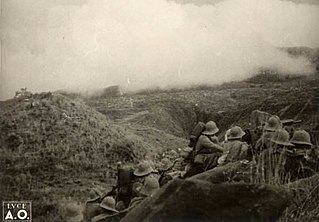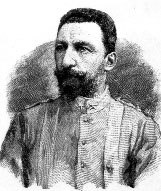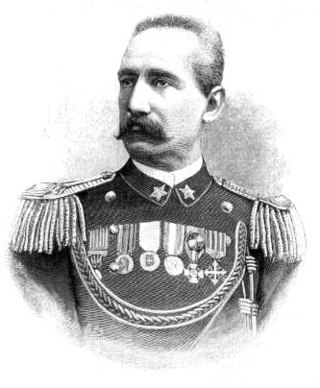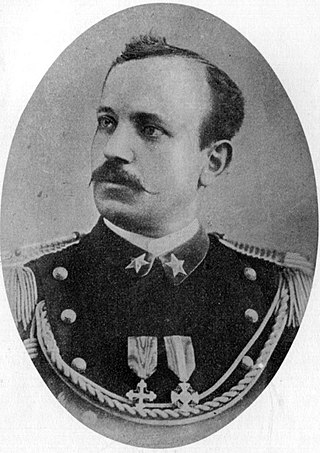
The Battle of Adwa was the climactic battle of the First Italo-Ethiopian War. The Ethiopian forces defeated the Italian invading force on Sunday 1 March 1896, near the town of Adwa. The decisive victory thwarted the campaign of the Kingdom of Italy to expand its colonial empire in the Horn of Africa. By the end of the 19th century, European powers had carved up almost all of Africa after the Berlin Conference; only Ethiopia and Liberia still maintained their independence. Adwa became a pre-eminent symbol of pan-Africanism and secured Ethiopian sovereignty until the Second Italo-Ethiopian War forty years later.

The First Italo-Ethiopian War also referred to as the First Italo-Abyssinian War; Italian: Guerra d'Abissinia, lit. Abyssinian War, was a war fought between Italy and Ethiopia from 1895 to 1896. It originated from the disputed Treaty of Wuchale, which the Italians claimed turned Ethiopia into an Italian protectorate. Full-scale war broke out in 1895, with Italian troops from Italian Eritrea achieving initial successes against Tigrayan warlords at Coatit, Senafe and Debra Ailà, until they were reinforced by a large Ethiopian army led by Emperor Menelik II. The Italian defeat came about after the Battle of Adwa, where the Ethiopian army dealt the heavily outnumbered Italian soldiers and Eritrean askaris a decisive blow and forced their retreat back into Eritrea. The war concluded with the Treaty of Addis Ababa. Because this was one of the first decisive victories by African forces over a European colonial power, this war became a preeminent symbol of pan-Africanism and secured Ethiopia's sovereignty until the Second Italo-Ethiopian War of 1935–36.

Menelik II, baptised as Sahle Maryam was King of Shewa from 1866 to 1889 and Emperor of Ethiopia from 1889 to his death in 1913. At the height of his internal power and external prestige, the process of territorial expansion and creation of the modern empire-state was completed by 1898.

Imba Alaje is a mountain, or an amba, in northern Ethiopia. Located in the Debubawi Zone of the Tigray Region, Imba Alaje dominates the roadway that runs past it from the city of Mek'ele south to Maychew. Because of its strategic location, Emba Alaje has been the location of several battles. As Anthony Mockler describes it,

Oreste Baratieri was an Italian general and governor of Italian Eritrea.

Bahta Hagos, died December 19, 1894, was Dejazmach of Akkele Guzay, and retrospectively considered an important leader of Eritrean resistance to foreign domination specifically against northern Ethiopian and Italian colonialism. He was born sometime between 1839 and 1850 into a rich peasant family in the town of Segheneyti and was killed in the Battle of Halai against the Italian Colonial Army on December 19, 1894. He was of the Tsena-Degle Tigrinyas, from Akele Guzay.

The Battle of Gondar or Capture of Gondar was the last stand of the Italian forces in Italian East Africa during the Second World War. The battle took place in November 1941, during the East African Campaign. Gondar was the main town of Amhara in the mountains north of Lake Tana in Ethiopia, at an elevation of 7,000 ft (2,100 m) and had an Italian garrison of 40,000 men, commanded by Generale Guglielmo Nasi.

The Battle of Coatit was fought on 13 January 1895 between Italy and Ethiopian proxies led by Tigrayan warlord Ras Mengesha Yohannes in what is now Eritrea. It was the opening battle of the First Italo–Ethiopian War, and was a significant victory for the Italians, as they rebuffed an invasion force.

Giuseppe Galliano was an officer of the Royal Italian Army, mostly known for his role during the First Italo-Ethiopian War. He perished in the Battle of Adwa and was posthumously awarded the Gold Medal of Military Valour.

The Battle of Amba Aradam was a battle fought on the northern front of what was known as the Second Italo-Abyssinian War. This battle consisted of attacks and counter-attacks by Italian forces under Marshal of Italy Pietro Badoglio and Ethiopian forces under Ras Mulugeta Yeggazu. This battle was primarily fought in the area around Amba Aradam which included most of Enderta Province.

The Royal Corps Of Eritrean Colonial Troops were indigenous soldiers from Eritrea, who were enrolled as askaris in the Royal Corps of Colonial Troops of the Royal Italian Army during the period 1889–1941.

Italian Eritrea was a colony of the Kingdom of Italy in the territory of present-day Eritrea. The first Italian establishment in the area was the purchase of Assab by the Rubattino Shipping Company in 1869, which came under government control in 1882. Occupation of Massawa in 1885 and the subsequent expansion of territory would gradually engulf the region and in 1889 borders with the Ethiopian Empire were defined in the Treaty of Wuchale. In 1890 the Colony of Eritrea was officially founded.

Italians of Ethiopia are Ethiopian-born citizens who are fully or partially of Italian descent, whose ancestors were Italians who emigrated to Ethiopia starting in the 19th century during the Italian diaspora, or Italian-born people in Ethiopia.

The Battle of Amba Alagi was fought in May 1941, during World War II, part of the East African Campaign. After the Italian defeat at Keren in April 1941, Prince Amedeo, Duke of Aosta withdrew his forces to the mountain stronghold at Amba Alagi. The mountain had galleries carved into the rock to protect the defending troops and hold ample ammunition and stores and the Italian troops thought themselves to be impregnable. According to other sources, however, the fortress was easily defendable thanks to its position and the mountainous terrain, but lacked food and water, so that Marshal Enrico Caviglia later criticised the Duke for having chosen it for his last stand, calling the Amba Alagi "uno scoglio senz'acqua e senza viveri". The initial attacks on the approaches to Amba Alagi by British troops under Major-General Mayne from the north, commenced on 4 May with a pincer from the eastern and western sides.

Giuseppe Edoardo Arimondi, OSML, OMS, OCI was an Italian general, mostly known for his role during the First Italo-Ethiopian War. He was one of the few European commanders who gained a victory over the Mahdists before Kitchener's Expedition, soundly defeating them at Agordat in 1893. After a long and successful colonial service, he died in combat at Adwa, and was posthumously awarded the Gold Medal of Military Valor.

Matteo Francesco AlbertoneOCI was an Italian general, mostly known for his role during the First Italo-Ethiopian War. He led the Native Brigade during the battle of Adwa and was taken prisoner by the Ethiopians.

The Battle of Debra Ailà(Debre Ailat) was a battle of the First Italo-Ethiopian War on October 9, 1895, where under the combined efforts of Italian colonial troops and Askari troops defeated the rearguard of the Tigrin army, which had withdrawn from Tigray's capital Mek'ele.
Alfredo Serranti was an officer in the Royal Italian Army during World War II. He was killed in action during the battle of Culqualber and posthumously awarded the Gold Medal of Military Valor.

Pietro Toselli was a major of the Royal Italian Army. He is mainly known for his participation in the First Italo-Ethiopian War. He was born in Peveragno in 1856, the youngest of three siblings. His father was Giovanni Maria Toselli, and his mother Teresa (Botasso) Toselli. His older brother Enrico Toselli was a noted psychiatrist and university professor. Pietro Toselli joined the army at a young age and was commissioned Second lieutenant of Artillery in 1878. After finishing the tree year curriculum for artillerymen he opted for additional training in military engineering. After finishing his education in 1880 he became a First lieutenant. In 1887 he was promoted to Captain. He first came to Africa in 1888 to carry out topographical work in the new colony of Italian Eritrea. Returning to Italy he published the book Pro Africa italica under the pseudonym "Un Eritreo". In 1894 he returned to Italian Eritrea to take command of the 4th Askari Battalion of the Corpo Speciale per L'Africa. He led Italian forces to victory at the Battle of Halai on the 18 December 1894, when his troops defeated the Eritrean forces of Batha Agos, who were besieging the Italian fort at Halai. On the 13 January 1895, he commanded the 4th Askari Battalion at the Battle of Coatit under the command of Oreste Baratieri. After the Ethiopian retreat Toselli, and the 4th Askari Battalion formed the Italian vanguard that caught up with the Ethiopian forces at the Battle of Senafe.

Domenico Turitto was an Italian major who was part of the Royal Colonial Corps of Eritrea. He participated in the Mahdist War as he commanded the 1st Indigenous Infantry Battalion, occupying the city of Kassala and distinguishing himself at the Battle of Kassala. During the First Italo-Ethiopian War, Turitto commanded the vanguard of the Indigenous brigade under the command of Matteo Albertone before being killed in the battle. He was also a recipient of the Silver and Bronze Medals of Military Valor and a knight of the Order of Saints Maurice and Lazarus.



















